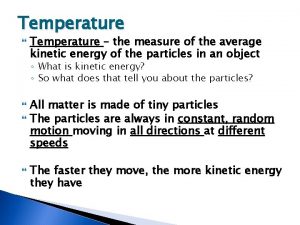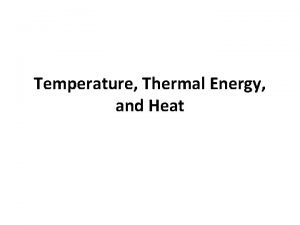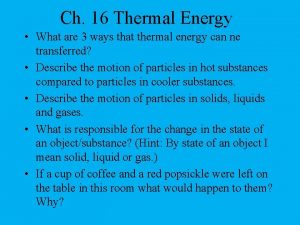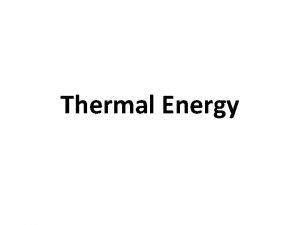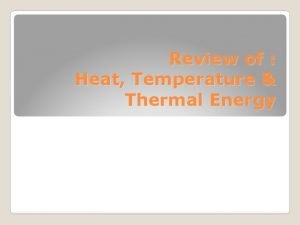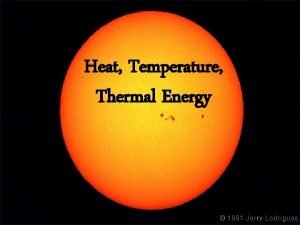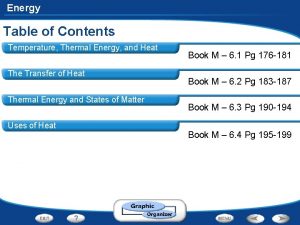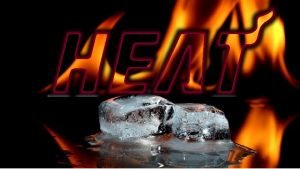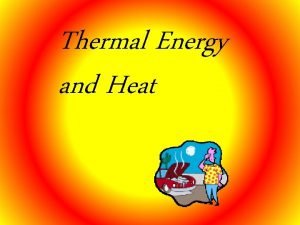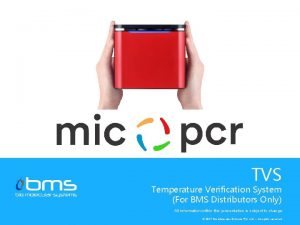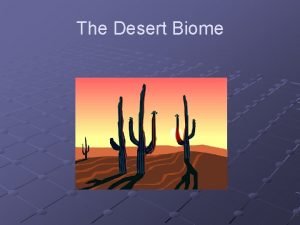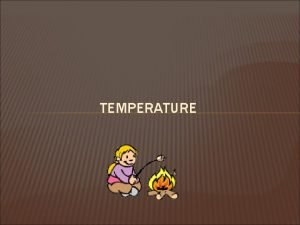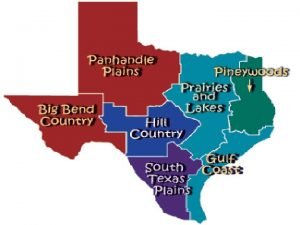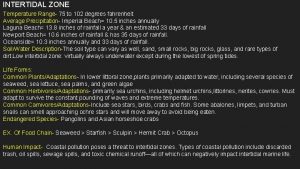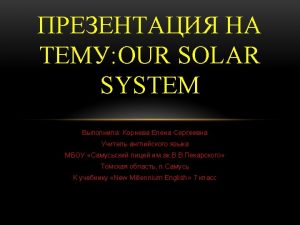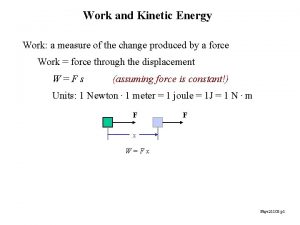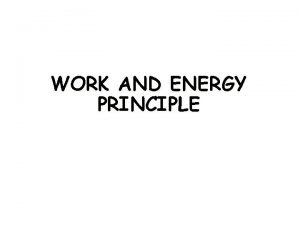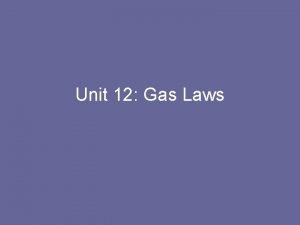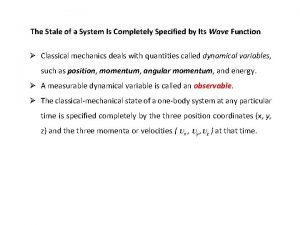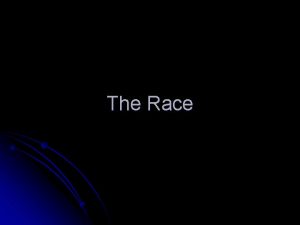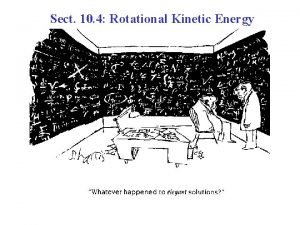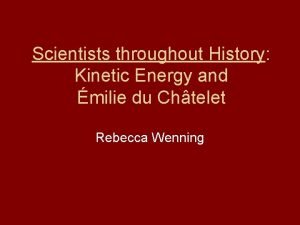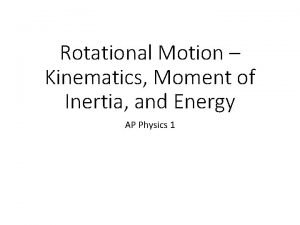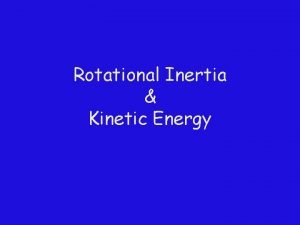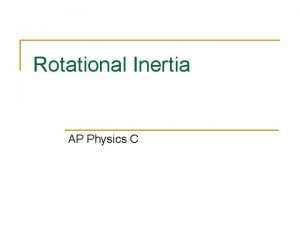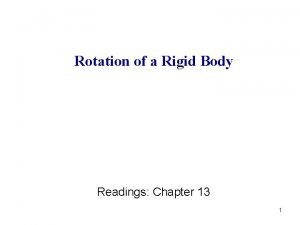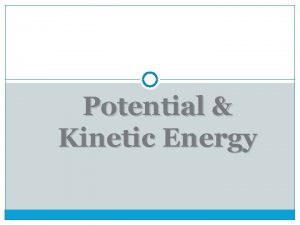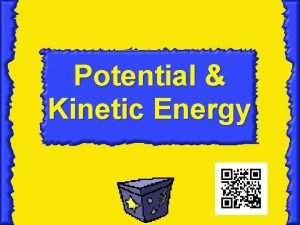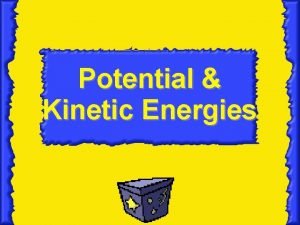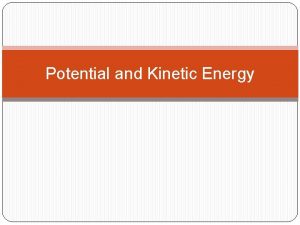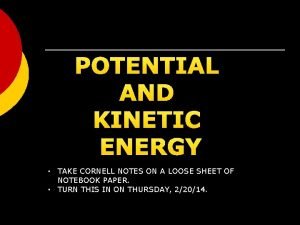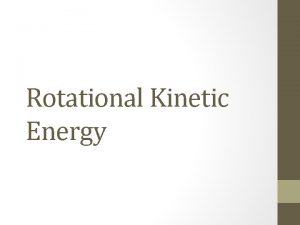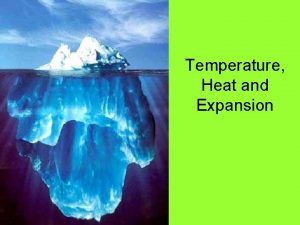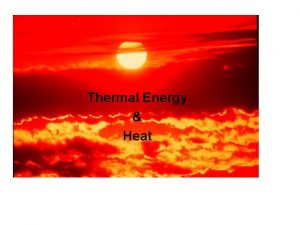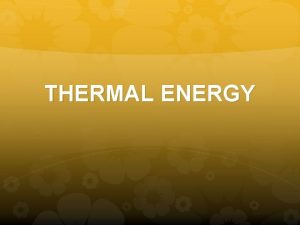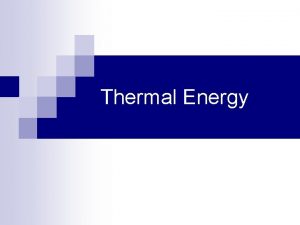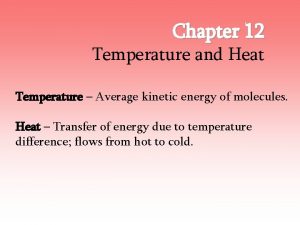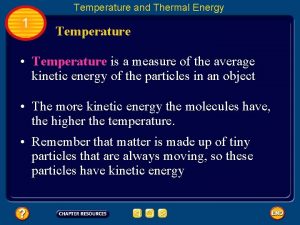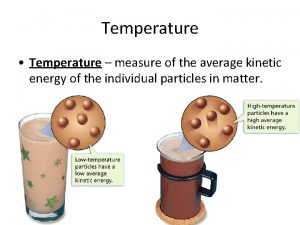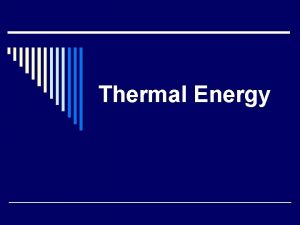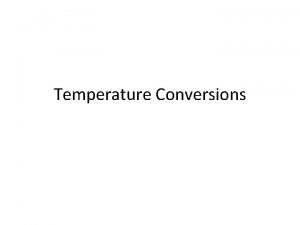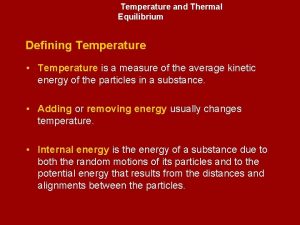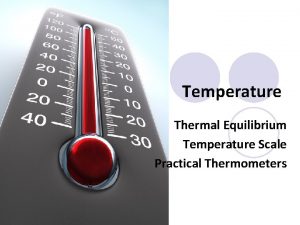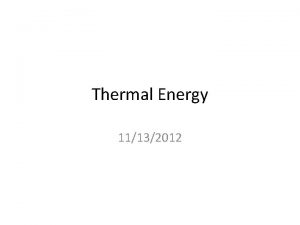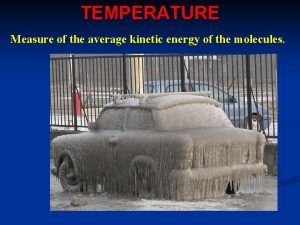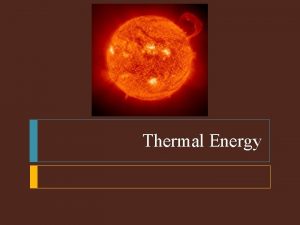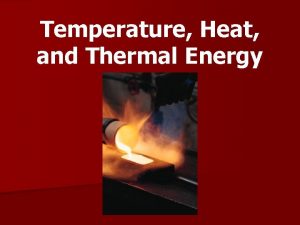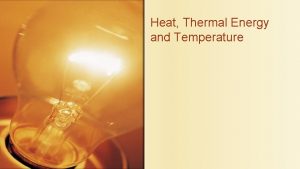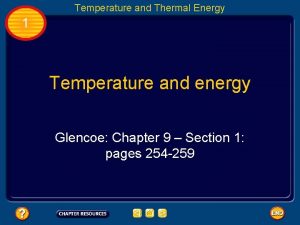Thermal Energy Temperature THE AVERAGE KINETIC ENERGY OF























































- Slides: 55

Thermal Energy

• Temperature – THE AVERAGE KINETIC ENERGY OF AN OBJECT. • Average motion energy • Thermal Energy – THE TOTAL KINETIC + POTENTIAL ENERGY IN AN OBJECT. • Energy of stored bonds + motion

• Temperature Reference Points • Freezing Point of Water – 0 °C or 32°F • Boiling Point of Water – 100°C or 212°F

Temperature Conversions TK = Temperature in Kelvin TC = Temperature in °C TF = Temperature in °F Temperature (°F) 212 32 0 Temperature (°C) 100


HEAT TRANSFER

1. Which object has the greatest temperature? 2. Which object has the greatest average kinetic energy? 3. Which object has the greatest total kinetic energy? 4. Which object has the greatest Thermal Energy? 5. Which object, left on its own, in outer space, has the greatest heat? 6. Which object, connected to the table, has the greatest heat transfer? A. 97°C 50 m. L B. 7°C 1 L C. -2°C 1000 k. L D. None of these

Heat • HEAT = THERMAL ENERGY THAT IS TRANSFERRED FROM ONE OBJECT TO ANOTHER. • HEAT ALWAYS FLOWS FROM THE HIGHER TEMPERATURE TO THE LOWER TEMPERATURE • Touch the leg of your chair and the leg of your desk. Which one is colder?

Pizza Capacity • Think and Explain? When I throw my pizza into the microwave to warm it up, it isn’t the same temperature throughout. Why?

Heat Capacity • All substances will change temperature as they gain thermal energy. • HEAT CAPACITY = THE AMOUNT OF TEMPERATURE CHANGE TO A HEATED OBJECT DEPENDS ON THE OBJECT AND THE MASS.

• The three methods of Heat Transfer – CONDUCTION – CONVECTION – RADIATION Modes of Heat Transfer

Conduction • CONDUCTION = THERMAL ENERGY TRANSFERRED BY THE COLLOSIONS OF PARTICLES • CONDUCTION REQUIRES CONTACT – It is an exchange of energy between atoms and electrons by collisions – Less energetic particles gain energy during collisions with more energetic particles.

Materials Listed are common materials. Better conductors have a higher thermal conductivity Demo - POOR CONDUCTOR = GOOD INSULATOR

Conduction Examples • Why is the tile cold and the carpet feel warm? • Because the tile is a better conductor and it has a greater heat capacity

Convection • What is convection? • THERMAL ENERGY TRANSFERRED BY A CURRENT OF FLUID • REQUIRES A FLUID(Gas/Liquid) – When the movement results from differences in density, it is called natural convection – When the movement is forced by a fan or a pump, it is called forced convection

Convection Heating • An example of natural convection • Explain what is happening • Water Temp Demo

Convection Current Example • What is the forced convection? • What is the natural convection?

Weather – due to natural convection

Radiation • RADIATION = THERMAL ENERGY TRANSFERRED BY ELECTROMAGNETIC WAVES • RADIATION DOES NOT REQUIRE CONTACT • All objects radiate (give off) energy continuously in the form of electromagnetic waves due to thermal vibrations of the molecules

Thermal Expansion • When an object is heated, it’s particles speed up and spread apart, making the object expand. • Demo - • Uses: Cavities, Bridges, Sidewalks Lines • Downsides - potholes

Radiation example • No physical contact is necessary • The electromagnetic waves carry the energy • The heat transfer cannot be accounted for by conduction or convection (thru space)

States of Matter

Picture Volume Shape Gas Liquid Solid Kinetic Energy Intermolecular Force

Picture Phase Summary Definite Kinetic Volume Shape Energy Intermolecular Force High Gas No No Sometimes bounce off one another None Medium Liquid Solid Yes No Yes Roll, Bounce off one another Low Shake back and Forth Weak Strong

States of Matter Notes • These are found online at • http: //prezi. com/_2 quyv 8 zpnzq/notes-statesof-matter/ • (Look at these or you’ll be sorry).

ing bli m Me ltin y I sit Dr po Least Kinetic energy = De g Definite Shape ion at Fre ez Amorphous Su Crystalline Fro Property of Viscosity st Medium Kinetic energy Molecules in motion me lu Vo e nit i f De No Definite Shape Fluid Condensation Vaporziation No Highest Kinetic Energy ce = ion Definite Volume

Phase Change Graphs

Thermal Energy and Phase Changes Gas 150 100 id Condensation Liq u 50 Melting 0 id Freezing Sol Temperature (°C) Vaporization 0 1 2 3 Thermal Energy 4 5

Phase Change Process (S & L) • Melting – THERMAL ENERGY IS USED TO BREAK BONDS – The bonds that hold molecules in vibrating lattice structure are breaking. – The Intermolecular Forces Lessen • Freezing – THERMAL ENERGY IS USED TO CREATE BONDS AND HOLD MOLECULES IN PLACE – The bonds that will hold molecules in position are forming – The Intermolecular Forces Increase –Melting Point – THE TEMPERATURE AT WHICH AN OBJECT EITHER MELTS OR FREEZES.

Evaporation = Escape • Brant’s Maximum Security Penitentiary for Incarcerated Dress Code Violators and Others. • If the highest IQ’s escape, what happens to the average Penitentiary IQ. – Up – Down – Same

VAPORIZATION (L – G) • EVAPORATION – A CHANGE IN PHASE FROM LIQUID TO GAS AT THE SURFACE. – This cools the remaining liquid! • BOILING – A CHANGE IN PHASE FROME LIQUID TO GAS BELOW THE SURFACE. – This cools the remaining liquid! • Boiling Point – THE TEMPERATURE THAT AN OBJECT VAPORIZES OR CONDENSES.

Condensation (G L) • CONDENSATION – A CHANGE OF PHASE FROM GAS TO LIQUID. • This is a WARMING PROCESS for the liquid. • Gas molecules strike surface of liquid and give up so much energy that they can’t stay in gaseous phase • Examples Droplets forming on mirror Droplets on glass of water

Condensation = Captured • The smart kids sneak out of a convocation in the gym and join the prison of ISS. What happens to the average IQ of the prison? – Up – Down – Same

Phase Changes with the Gizmo • The differences with this type of graph, and the basic phase change graph is that the time is the x-axis instead of changing thermal energy. • Hint: In these graphs Mr. Nuetzel had an initial setup, then didn’t change any of the settings after starting it.

Phase Change Gizmo With this setup, what will happen to the temp. graph?


Phase Change Gizmo With this setup, what will happen to the temp. graph?


Phase Change Gizmo With this setup, what will happen to the temp. graph?


Phase Change Gizmo With this setup, what will happen to the temp. graph?


What’s the difference between these two graphs?

What’s the difference between these two graphs?

Phase Change Gizmo With this setup, what will happen to the temp. graph?


Interpreting Graphs • Hint – Mr. Nuetzel didn’t keep the RATE of heat transfer constant in these graphs.

What is happening in this graph?

What is happening in this graph?

What is the difference in these graphs?

What is happening in this graph?

What is happening in this graph?

What is happening in this graph?

Acting Out Phase Changes • Get in a group of 8 -12 students. You will have 2 minutes to decide how you want to act out one of the phase changes that H 2 O can go through with either an addition or subtraction of thermal energy. • Demonstrate your skit to the class.

Review Discussion Questions • Explain in detail and use thermal energy vocabulary. • When I throw my pizza into the microwave to warm it up, it isn’t the same temperature throughout. Why? • How is the house heated? • How does a thermometer work?
 Temperature measure average kinetic energy
Temperature measure average kinetic energy Mass and thermal energy
Mass and thermal energy Section 3 using thermal energy
Section 3 using thermal energy How to measure heat energy
How to measure heat energy Which has more thermal energy a tiger or a house cat
Which has more thermal energy a tiger or a house cat Venn diagram of heat and temperature
Venn diagram of heat and temperature Heat vs thermal energy vs temperature
Heat vs thermal energy vs temperature Heat thermal energy and temperature
Heat thermal energy and temperature Thermal energy vs heat
Thermal energy vs heat How are thermal energy and temperature different
How are thermal energy and temperature different Heat vs thermal energy vs temperature
Heat vs thermal energy vs temperature Thermal energy vs temperature
Thermal energy vs temperature Thermal energy vs. temperature
Thermal energy vs. temperature Is temperature a measure of thermal energy
Is temperature a measure of thermal energy Thermal transfer vs direct thermal printing
Thermal transfer vs direct thermal printing Thermal cycler temperature verification system
Thermal cycler temperature verification system Potential energy spring
Potential energy spring Gravity kinetic
Gravity kinetic Gravitational potential energy vs kinetic energy
Gravitational potential energy vs kinetic energy Kinetic potential
Kinetic potential Kinetic energy and potential energy
Kinetic energy and potential energy Types of potential energy
Types of potential energy Gravitational potential energy
Gravitational potential energy Formula of potential energy
Formula of potential energy Differentiate between average speed and average velocity
Differentiate between average speed and average velocity What is the average temperature for tropical rainforest
What is the average temperature for tropical rainforest Average temperature in taiga
Average temperature in taiga Cold desert biome
Cold desert biome Temperature is the measure of the average
Temperature is the measure of the average Temperate deciduous forest locations
Temperate deciduous forest locations Gulf coast prairies and marshes average rainfall
Gulf coast prairies and marshes average rainfall Intertidal zone average temperature
Intertidal zone average temperature Clifden ireland average temperature
Clifden ireland average temperature Whats the average temperature on mercury
Whats the average temperature on mercury Temperature is a measure of the average
Temperature is a measure of the average Difference between curie temperature and neel temperature
Difference between curie temperature and neel temperature Difference between curie temperature and neel temperature
Difference between curie temperature and neel temperature Difference between curie temperature and neel temperature
Difference between curie temperature and neel temperature Kinetic energy
Kinetic energy Ads=vdv example
Ads=vdv example Relation between pressure and kinetic energy of gas
Relation between pressure and kinetic energy of gas Kinetic energy operator
Kinetic energy operator Translational kinetic energy
Translational kinetic energy Moment of inertia of disc
Moment of inertia of disc History of kinetic energy
History of kinetic energy Kinetic rotational energy formula
Kinetic rotational energy formula Moment of inertia of a dumbbell
Moment of inertia of a dumbbell Kinetic angular energy
Kinetic angular energy Linear kinetic energy
Linear kinetic energy Rigid body
Rigid body Kinetic energy in volleyball
Kinetic energy in volleyball Kinetic and potential energy
Kinetic and potential energy Graphic organizer about kinetic energy
Graphic organizer about kinetic energy Kinetic and potential energy
Kinetic and potential energy Examples of kinetic energy
Examples of kinetic energy Potential energy
Potential energy
